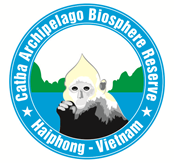BIODIVERSITY OF CAT BA BIOSPHERE RESERVE
Cat Ba Archipelago (located in Haiphong City, Vietnam) has an important role in the map of global conservation and sustainable development, where has recorded and been designated with several national and international titles, such as: (1) National Park (1986), (2) Biosphere Reserve (2004), (3) Proposed Global Geopark (2007), (4) Learning Lab for Sustainable Development (2009), (5) Record: Biosphere Reserve with the most tourist attraction (2014), (6) Marin Protected Area (2010), (7) Largest primary tropical moonson forest on limestone islands (2011); (8) Largest Mangrove forest on islands (2011), (9) Archipelago with the most marine lakes (2011), (10) National beautispot (2012), (11) Archipelago with the most number of islands and islets in Vietnam (2012), (12) Largest limestone island in Southeast Asia (2013), (13) National Special Monument (2013), (14) Island with most number of fresh water crab species (3/8 species), (15) Nominated PSSA (2015), (16) Proposed World Heritage site (2011 & 2016), (17) Proposed Lan Ha Bay as one of the Most Beautiful Bays in the World (2016).
Cat Ba Biosphere Reserve has remarkable initiative such as: pioneering Vietnam’s model for biosphere reserve management board (2005), which is interdisciplinary, intersectoral and led by a deputy provincial governnor; first institutionalised management regulations for biosphere reserve (2005), Sustainable Development Fund (2009), Biosphere Reserve Certification Label for quality economy products and services (2010), and first Biosphere Reserve Enterpreneurial Association (2012). Cat Ba Archipelago and Lan Ha Bay share Halong Bay universal outstanding natural values, one of the 7 New Natural Wonders.
Global Biodiversity Values
Cat Ba Archipelago and adjacent area has recorded 4,637 species of terrestrial, freshwater, coastal and marine plants and animals, including:
– 2,449 terrestrial species: Mamals: 72 (1 shrew, 1 treeshrew, 30 bats, 2 primates, 3 ferrets, civets 4, 11 carnivors, 1 serow, 18 roddens), 214 birds, 72 reptiles, 33 amphibians, 150 land snails, 1,589 vascular plants, 44 mushrooms, 274 insects;
– 14 fresh water species: 3 crabs, 11 fishes (no data on other fresh water species);
– 37 mangroves (11 true mangrove plants);
– 2,137 marine species: 160 seaweeds, 4 seagrasses, 450 phytoplanktons, 154 zooplanktons, 743 zoobenthos, 247 corals, 361 marine fishes, 4 turtle, 4 sea mamals (dolphins), 7 seasnakes, 12 sea algaes.
Cat Ba – Ha Long area has estimatedly 93 endemic species, mostly land snails.
– 73 endemic animal species: Cat Ba Langur/ Golden-headed Langur (Trachypithecus poliocephalus, Pousargues, 1898), Halong leaf-nosed Bat (Hipposideros alongensis, (Bourret) Thong et al 2011), Cat Ba Tiger Gecko (Goniurosaurus catbaensis, Ziegler, Truong, Schmitz, Stenke, Rösler, 2008), Trung Trang air-breathing land snail (Oospira smithi, Maassen & Gittenberger 2007), Cat Ba cave Crab (Tiwaripotamon edostilus, Ng & Yeo 2001), Cat Ba tree frog (Philautus catbaensis (Milto, Poyarkov, Orlov, Nguyen 2013), Cat Ba shrub frog (Liuixalus catbaensis, Nguyen, Matsui, Yoshikawa 2014), Subterranean Eyeless Dragon Loach (Draconectes narinosus, Kottelat 2012), Eyeless subterranean water louse (Seborgia vietnamica, Jaume, Sket & Boxshall, 2009), Eyeless subterranean water mite (Nilotonia sketi, Persic 2013), Tonkin Forest Skink (Sphenomorphus tonkinensis, Nguyen, Schmitz, Nguyen, Orlov, Boehme & Ziegler 2011), Cat Ba Giant clausiliid snail (Oospira pycnosoma, Gittenberger & Vermeulen), Khoan Cao stream crab (Laevimon kottelati, Yeo & Ng 2005); Long-legged pisin cave spider (Belisanna pisinna Yao, Phạm & Li 2015), Long-legged Hochiminh cave spider (Pholcus hochiminhi, Yao, Phạm & Li 2015), Halong Long-legged cave spider (Belisana halongensis, Yao, Phạm & Li, 2015); 51 endemic snails of Cat Ba – halong region (Vermeulen & Maassen 2003), two endemic fish species and 6 endemic Crustacean species in the flooded caves (B. Sket), and one endemic Jelly fish in the marine lakes.
– 20 endemic plant species: Halong Umbrella tree (Schefflera alongensis, R. Vig.), Halong Palm (Livistona halongensis, Kiew &T. H. Nguyen), Halong Impatiens (Impatiens halongensis Kiew &T. H. Nguyen), Halong Cycas (Cycas tropophylla, K. D. Hill& P. K. Lôc), Drake Gentian subshrub (Primulina drakei, (B.L.Burtt) Mich.Möller & A.Weber), Gemella Gentian subshrub (Chirita gemella, D. Wood.), Halong Gentian subshrub (Primulina halongensis, Kiew & T.H.Nguyên) Mich.Möller & A.Weber), Hiep Gentian subshrub (Chirita hiepii Kiew & T. H.Nguyen), Modest Gentian subshrub (Chirita modesta, Kiew & T. H.Nguyen), Halong parabea subshrub (Paraboea halongensis, Kiew &T. H. Nguyen), Halong Neolitsea subshrub (Neolitsea alongensis, Lecomte), Long stem Munro shrub (Munronia petiolata, N. T. Cuong, D. T. Hoan & Mabberly 2014), Halong ficus (Ficus superba var. alongensis), Pedal Coralberry (Ardisia pedalis), Halong Jasmin (Jasminum alongensis, Gagnep), Oldenland lecomte subshrub (Hedyotis lecomtei, (Pit.) P.H.Ho), Levis Soapberry (Allophylus leviscens), Halong felt cap plant (Pilea alongensis, Gagnep), Halong Ginger ( Alpinia calcicola), Purple Terrestrial Orchid (Zeuxine vietnamica, Aver 1988).
There are 114 species in the IUCN Red List (110 coral spp. 3 turtle spp, 01 marine mammal), 14 species listed in Vietnam Red Book (6 zooplankton, 01 coral, 4 turtle, 1 marine mammal). Cat Ba Langur/ Golden-headed Langur is one of the 25 most endangered primates since 2000, which currently consists of less than 60 individual left in the wild. Serow has the highest extinction risk in local island, with less than 20 individuals left in Cat Ba Island
